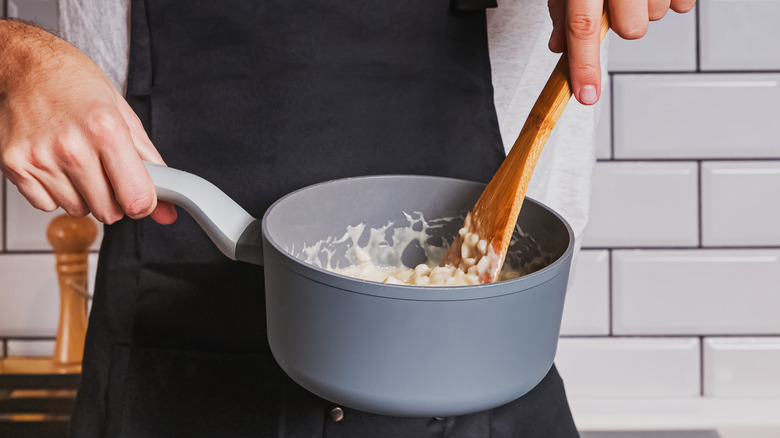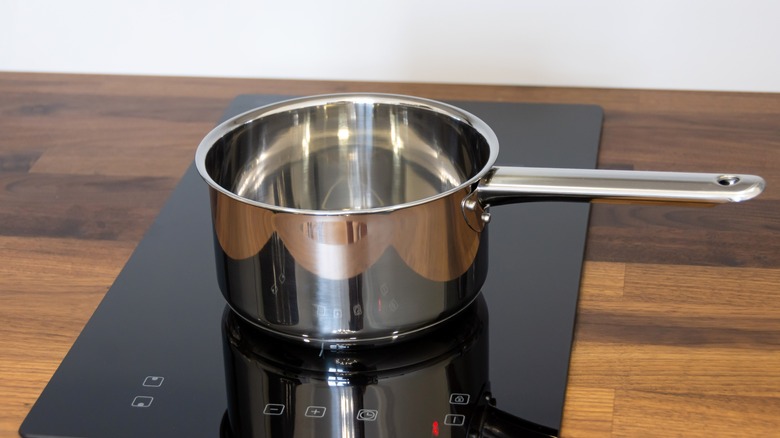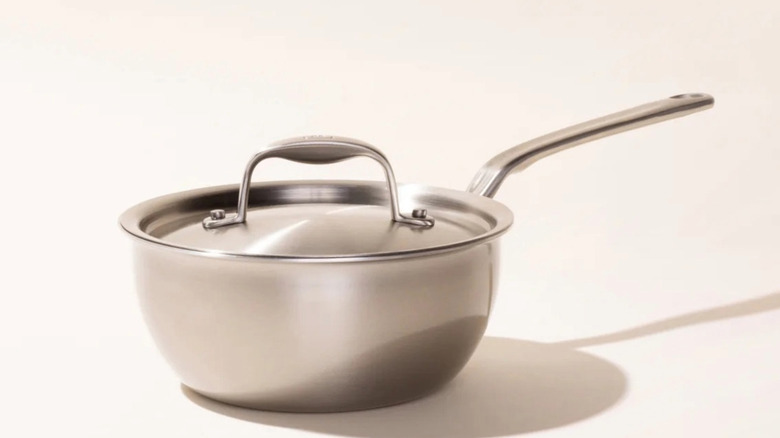No, Saucepans And Sauciers Are Not The Same
While the contents of one kitchen to another vary wildly depending on the expertise and interest in cooking of the people living in the house, one tool that can almost always be found is some kind of saucepan. With a long handle and manageable size, it's the go-to pan for everything from making boxed mac and cheese to heating up milk for hot cocoa to blanching green beans.
However, if you see a pan in your cabinet, at a kitchen store, or at a flea market and notice that its sides are gently curved and rounded, rather than straight up and down, what you're looking at is actually a saucier. To the uninitiated, it may seem at first glance to be just another saucepan, though perhaps a little shorter. As it turns out, saucepans and sauciers are designed for different jobs in the kitchen; while a saucepan is a bit of a workhorse, sauciers excel as vessels for cooking sauces! Here's what you need to know about these two different pans.
Here's what saucepans are best for
You know you have a saucepan when you see a small to medium-sized pot with straight sides and a long handle on the side. These pans are smaller than stockpots, which are large enough to hold gallons of simmering soups or stews. Saucepans have more depth than skillets or frying pans, which means they can hold bubbling mixtures with enough room to reduce the chance of a boilover.
Saucepans are available in an array of sizes; some hold several quarts, but others are tiny enough to hold just a few cups. The one long handle is the giveaway, however. Pots that have two looped handles are called braziers or saucepots. Saucepans are available in an array of materials, including stainless steel, copper, enameled cast iron, and carbon steel.
A must-have for every kitchen, saucepans are versatile and an all-around great piece of cookware to have on hand. Use saucepans to boil water for everyday ingredients like whole eggs, pasta, and rice. Use them to cook fresh and frozen veggies and to make boxed-mix meals and sides. And, of course, people do use these pots to cook up sauces. However, even though it has "sauce" in the name, there is a pot that's even better for cooking sauces — and that's a saucier.
Choose a saucier for the best sauce ever
In the brigade system of French kitchens, saucier is the term for the chef in charge of the sauces, but it's also the name of this special pan. A saucier comes in sizes similar to those of saucepans and also has a long, single handle. The difference, however, is in the shape of the pan. The straight sides of a saucepan meet the bottom at more or less a 90-degree angle, creating a corner around the inside-bottom of the pan. In contrast, the sides of a saucier are curved to create more of a bowl shape. Why is this important?
Many sauces and creamy dishes like risotto need frequent stirring with a spoon or whisk to create a silky texture and to prevent them from sticking and burning on the bottom. The curved shape of a saucier is a perfect fit for these utensils. Another benefit: The sharp corner created by a saucepan's straight sides is a magnet for food to build up and burn; since a saucier doesn't have this, it's really easy to keep contents moving to create a consistent, delectable texture. A good saucier pan will also have a thicker bottom made from materials that conduct heat evenly, reducing hot spots and the chance that delicate sauces will burn.
Can you get away with making sauces in a saucepan? Of course. However, if you really take pride in perfectly-executed sauces, risotto, and from-scratch pastry cream for desserts, a saucier is a worthwhile investment for your kitchen.


